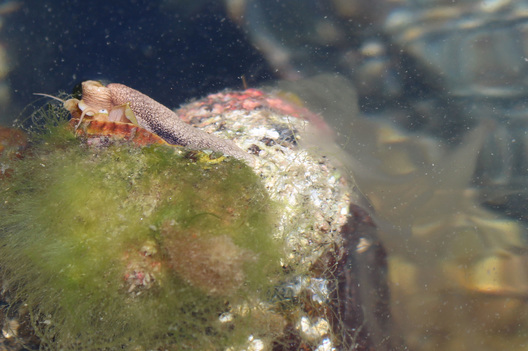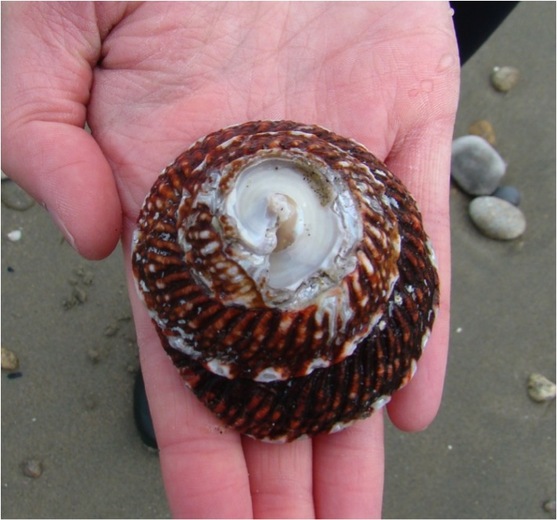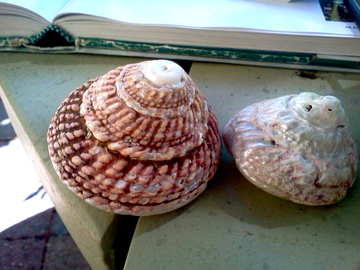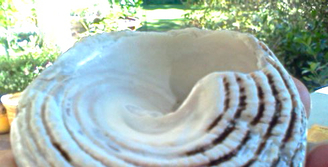Red turban snail • Pomaulax gibberosus, Lithopoma gibberosum, Astraea gibberosa
{Astraea = starry, gibberosa = hunched}
|
Top left: red turban snail releasing sperm. Photo by Sara Wickham. Other photos: red turban shells in various stages of wear and tear. A pearly white inner layer is visible in areas that see the most wear and tear, and in the inside where the top was snapped off in the bottom left photo. This was likely from a crab attack. The jagged edge in the closeup photo at bottom right is likely the mark of a crab attack as well, where a claw managed to get a grip on the edge and snap off a third of the first whorl. This would likely be fatal to the snail. Left photo by Drew Baker, right photos by Kelly Fretwell.
|
Identification
The red turban snail is one of the larger, more striking marine snails found on the Central Coast. It has a wide, rounded base that tapers quickly to a point, giving the shell a wide cone shape. The shell is a brownish, brick red colour, and has a distinctive texture: a bumpy, ridged pattern circles the shell in the direction of the shell whorls. This pattern is particularly evident when some of the shell's brown outer layer (periostracum) has been worn away. The shell may be encrusted with coralline algae, but this pattern should still be visible. The red turban snail's shell can reach 11 cm in diameter.
Habitat & Range
This species is often found on rocky, exposed shorelines. It lives in the intertidal zone to 80 m deep. It is commonly found around the giant perennial kelp (Macrocystis integrifolia), which provides it with both food and shelter. The red turban's range extends along the west coast of North America from southern Alaska to northern Mexico, though it is not commonly found on the Washington and Oregon coasts.
Similar Species
The dusky turban (Tegula pulligo) shell has a longer spire and a narrower shape, has more rounded whorls, is smooth, and is generally smaller. The purple-ring topsnail (Calliostoma annulatum) has much more vibrant colouring, a longer spire, and is generally smaller. The blue topsnail (C. ligatum) is also smaller, has a longer spire, and has more rounded whorls.
Human Uses
The pearly white, oval-shaped operculum was traditionally used by the Haida and southeast Alaskan first nations to decorate wooden boxes, masks, and bowls (see this NMAI Collections search for more examples). Commercial harvests are a possibility, but do not appear to be occurring at this time.
Intriguing Info
Red turban snail shells were collected in Nootka Sound on Captain James Cook's explorative voyage along the coast of the Pacific Northwest, during his search for the Northwest Passage.
iNaturalist
https://www.inaturalist.org/taxa/424487-Pomaulax-gibberosus
The red turban snail is one of the larger, more striking marine snails found on the Central Coast. It has a wide, rounded base that tapers quickly to a point, giving the shell a wide cone shape. The shell is a brownish, brick red colour, and has a distinctive texture: a bumpy, ridged pattern circles the shell in the direction of the shell whorls. This pattern is particularly evident when some of the shell's brown outer layer (periostracum) has been worn away. The shell may be encrusted with coralline algae, but this pattern should still be visible. The red turban snail's shell can reach 11 cm in diameter.
Habitat & Range
This species is often found on rocky, exposed shorelines. It lives in the intertidal zone to 80 m deep. It is commonly found around the giant perennial kelp (Macrocystis integrifolia), which provides it with both food and shelter. The red turban's range extends along the west coast of North America from southern Alaska to northern Mexico, though it is not commonly found on the Washington and Oregon coasts.
Similar Species
The dusky turban (Tegula pulligo) shell has a longer spire and a narrower shape, has more rounded whorls, is smooth, and is generally smaller. The purple-ring topsnail (Calliostoma annulatum) has much more vibrant colouring, a longer spire, and is generally smaller. The blue topsnail (C. ligatum) is also smaller, has a longer spire, and has more rounded whorls.
Human Uses
The pearly white, oval-shaped operculum was traditionally used by the Haida and southeast Alaskan first nations to decorate wooden boxes, masks, and bowls (see this NMAI Collections search for more examples). Commercial harvests are a possibility, but do not appear to be occurring at this time.
Intriguing Info
Red turban snail shells were collected in Nootka Sound on Captain James Cook's explorative voyage along the coast of the Pacific Northwest, during his search for the Northwest Passage.
iNaturalist
https://www.inaturalist.org/taxa/424487-Pomaulax-gibberosus
References
Harbo, R. M. (2011). Whelks to whales: Coastal marine life of the Pacific Northwest. Madeira Park, BC: Harbour Publishing. P. 137.
Lamb, A., and Hanby, B. (2005). Marine Life of the Pacific Northwest. Madeira Park, BC: Harbour Publishing. P. 234
Authors and editors of page
Kelly Fretwell and Brian Starzomski (2013).
Harbo, R. M. (2011). Whelks to whales: Coastal marine life of the Pacific Northwest. Madeira Park, BC: Harbour Publishing. P. 137.
Lamb, A., and Hanby, B. (2005). Marine Life of the Pacific Northwest. Madeira Park, BC: Harbour Publishing. P. 234
Authors and editors of page
Kelly Fretwell and Brian Starzomski (2013).








